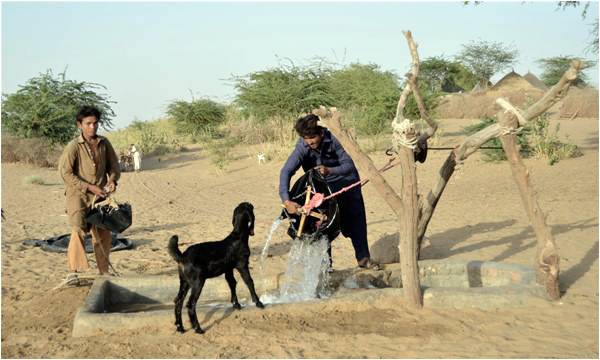
Leaving Naukot, the bus makes its way through Thar. The wavy road in the yellowish sandy bhits (dunes) seems like a long black cobra crawling towards you. You can feel the fragrance of newly sprouted berries in the air. The soil is swathed in green grass. The trees all seem washed. The beautiful landscape grabs your attention.
The driver turns on the tape. Fouzia Soomro’s Dhatki song echoes in the bhits;
Dell ri morerrey san jorri laagy phutri,
tu kiyan balim baitho pardess,
Awey re mithoara heth barsyo ahe megh Malhar
(The peahen looks beautiful in the peacock’s companionship,
Why are you living away?
Come my beloved, the rains have come here!)
The Thar Desert consists of eleven parts. After four years of continual droughts, all the parts have received - more or less, timely or belated - rainfalls this monsoon.
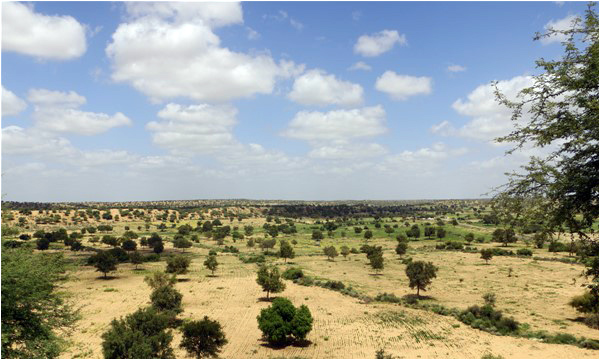
An influx into Thar
I try to chat with a young man sitting beside me. He introduces himself as Mushtaq. He is going to Islamkot from Karachi.
“We are, in fact, five neighbours returning home!” he looks towards the backseats where they seem absorbed in music.
They worked in Karachi at different places; Mushtaq is going to his village after seven months, while some of his companions haven’t visited for eight to ten months. “We did not go back on the previous Eid, but now there are huge rains, so we can’t help it…” he smiles.
Tharis are considered hardy enough to live for months away from home, but it’s only the rain which makes them feel homesick for their homeland. It is therefore said that whenever there are rains, all occupations seem insignificant to them - wherever they are, in whatever condition they might be, they just can’t stay away from their homes.
In Hyderabad, you would find three to five waiters in every hotel who come from Tharparkar or Umerkot. Hundreds of them also work in Karachi, Mirpurkhas, Nori Abad, Thata, Badin and other cities, on very meagre wages. Most of them are waiters, labourers in garment factories and cooks. Some also run their tea and Paan kiosks along the roadsides.
Mushtaq tells me that they will not go back to Karachi anytime soon. Instead they plan live here and look after the lands that their families have sown.
“Will the land produce enough crops for you to make ends meet?” I ask.
“Whether we get less or more, it’s our own, and we are happy with it!” he replies.
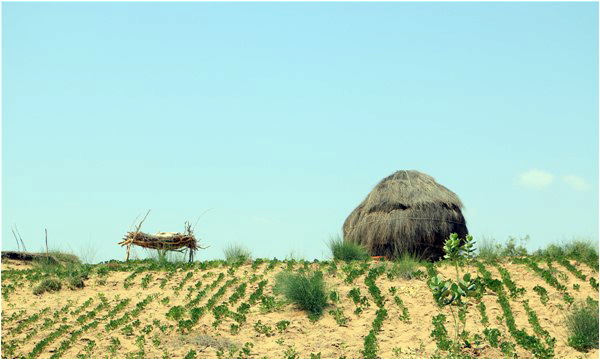
Similarly, hundreds of families and cattle herders who had migrated to other areas in search of livelihood and good pastures have also come back. Tamachi Bheel, 30, has returned to his ancestral village Katho Bheel, near Mithi, with his eight family members from Golarchi, Badin.
Tharparkar is home to 1.6 million people. It has the lowest Human Development Index of all districts in the province. Where malnutrition is high, hundreds of children die every year because of famine. Newspaper reports suggest 326 children died only in 2015. Thar is a place where migration is a usual occurrence. According to a report, 25 to 30 percent of total population migrates to barrage-watered areas every year due to drought. Most of Tamachi’s neihbours deserted the village a year ago.
“I was farming some land near Badin. We cut sugarcane, planted rice and grew sunflowers. We toiled all year but we are returned with empty hands - all we earned is just what we consumed there!” says Tamachi.
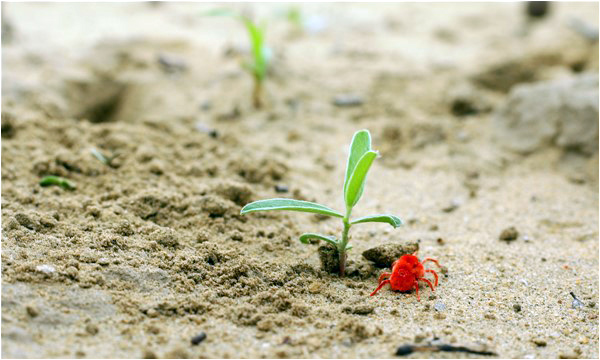
Is the drought over?
Pehlaj Mal, a resident of Khelatari, Diplo (western part of Thar) and his four friends have come with their herds of cattle two weeks ago from Khorwah, Badin. It took them five days to reach the village. But unfortunately, they are compelled to herd their 150 cows to Werhar, a village situated in the southern part of Thar, in search of fresh grass and water.
“Our cows relied on fodder and hay in Khorwah, which we purchased by selling milk. After the rains, we thought there would be lush grass and plenty of water in the village, but here it is other way around. There is grass that is not healthy to animals - good gross hasn’t grown up yet. There is also a shortage of water. We have to fetch it from a well to water our cows”, he tells me.
The monsoons start from the 15th of June. If it doesn’t rain until the 15th of August, drought is declared officially.
Tharparkar district is divided into seven tehsils (now Kaloi makes the seventh). Three tehsils - Diplo, Nagarparkar and Dahli - received untimely rainfall in August, which was not enough for crops and grass to grow, hence they face a drought-like situation, while two - Mithi and Chachro - of the remaining three are likely to suffer if rains don’t come. Islamkot is the only tehsil which received rains in June, July and August properly.
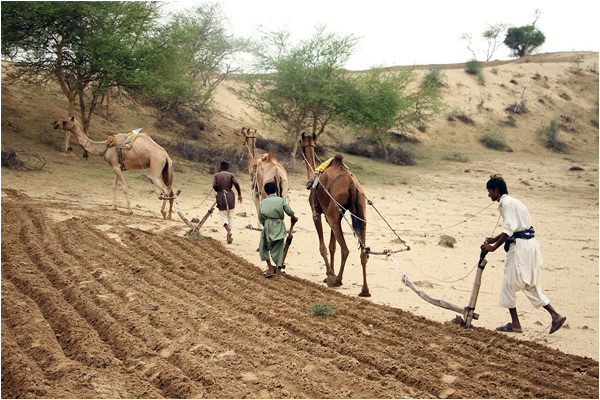
Ali Akbar Rahmoon, CEO of the Association for Water Applied Education and Renewable Energy (AWARE), says that many parts of Thar have received little or untimely rains, therefore, grass and crops will not be that good. They need a lot more rain. “Due to climate change, rainfall patterns have shifted; the result is erratic and untimely rains. Consequently, agricultural output is affected. Now crops are not ripening and winter is coming, which will cause disease in crops and low yields.”
“Due to continual droughts, seeds for good grass have become extinct: now there are types of grass which make Thar greener but are not healthy for the cattle. Governmental institutions like AZRI (Arid Zone Research Institute) should conduct research on it and new kinds of seed should be introduced which can grow with less water and sustain themselves in cooler weather”, added Akbar.
Poor livelihood
Tamachi Bheel has planted bajra (millet), gowar and some other seeds in his small piece of land. he waits for more rains to come. “I bought expensive bajra seed at the price of Rs 1,500 per 40 kg and gowar at Rs 2,500 per 40 kg, because I had sold all the seed saved during the four years of drought. But now, when crops are yet to ripen, the former is lowered to 1,000 per 40 kg and the latter to Rs 1,300 per 40 kg. Now if it doesn’t rain, all my investment will go down the drain.” he said.
Thar is also home to 60 million cattle. When there are a large number of cattle, there run special vehicles for carrying milk from different places to the nearer cities, where milk-based sweets like mava are made at bathis. However, people can’t supply milk to the big cities; as a result, they have no option other than selling milk at a low price.
Pehlaj sells 120 kg milk to Mawa Bathis in Kaloi city. “In Khorwah, we sold milk at Rs 46 per kg; here we have to sell it at a price as cheap as Rs 32 per kg. Since there is not plenty of grass, our cows rely on fodder that is Rs 1,000 per 40 kg. A cow eats 120 kg of fodder per week and gives 40 kg milk in return. It’s not profitable” explains Pehlaj.
Social activist Bharu Mal Amrani feels it is the duty of government institutions to aid people in situations like this. This year, that people deprived of seed bought if from shops. Jacobabad’s millet is planted in Thar this time, which is inappropriate to the climate of Thar.
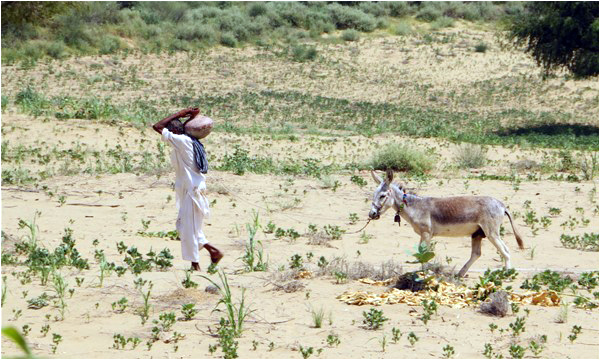
“The government should provide seeds to the farmers appropriate to the environment of Thar. It is seen that dealers exploit every opportunity. First they make the seeds expensive, and when crops are harvested, prices are lowered abruptly. When there is enough milk in Thar, prices are lowered. Therefore, the government should purchase crops and milk. The government should also conduct surveys: those Dehs facing drought shoul be declared drought-hit. Agriculture taxes should be waived” he added.
Migration begins
These days, many visitors from different cities are visiting Thar - speedy coasters, cars, vans and motorcycles running on country’s finest Thar coal road. They stop their vehicles wherever they see a small pond of water or a poor boy selling vegetables from Thar. They are taking selfies, children are playing with the wet sand. Their last resort is definitely Nagarparkar.
At the same time, there are people making the opposite journey. You can see families with their animals laden with luggage, walking their way to different areas of Lar, where the rice crop is ripe for harvest and cotton is ready to be picked. Despite having the country’s finest roads, most of them still can’t afford to travel in a small truck.
Some families from Tamachi’s village have left their homes. They, disappointed by the poor growth of the crops they have planted in Thar, don’t want to lose another opportunity that they have at hand, in the harvest.
“I will wait for a few days more. If it doesn’t rain, I will also go join the harvest!” says Tamachi.
To me, it suggests that Pehlaj Mal and his four friends, too, will have to make their five-day journey back to the Khorwah very soon.
The driver turns on the tape. Fouzia Soomro’s Dhatki song echoes in the bhits;
Dell ri morerrey san jorri laagy phutri,
tu kiyan balim baitho pardess,
Awey re mithoara heth barsyo ahe megh Malhar
(The peahen looks beautiful in the peacock’s companionship,
Why are you living away?
Come my beloved, the rains have come here!)
The Thar Desert consists of eleven parts. After four years of continual droughts, all the parts have received - more or less, timely or belated - rainfalls this monsoon.

Tharparkar is home to 1.6 million people. It has the lowest Human Development Index of all districts in the province
An influx into Thar
I try to chat with a young man sitting beside me. He introduces himself as Mushtaq. He is going to Islamkot from Karachi.
“We are, in fact, five neighbours returning home!” he looks towards the backseats where they seem absorbed in music.
They worked in Karachi at different places; Mushtaq is going to his village after seven months, while some of his companions haven’t visited for eight to ten months. “We did not go back on the previous Eid, but now there are huge rains, so we can’t help it…” he smiles.
Tharis are considered hardy enough to live for months away from home, but it’s only the rain which makes them feel homesick for their homeland. It is therefore said that whenever there are rains, all occupations seem insignificant to them - wherever they are, in whatever condition they might be, they just can’t stay away from their homes.
In Hyderabad, you would find three to five waiters in every hotel who come from Tharparkar or Umerkot. Hundreds of them also work in Karachi, Mirpurkhas, Nori Abad, Thata, Badin and other cities, on very meagre wages. Most of them are waiters, labourers in garment factories and cooks. Some also run their tea and Paan kiosks along the roadsides.
Mushtaq tells me that they will not go back to Karachi anytime soon. Instead they plan live here and look after the lands that their families have sown.
“Will the land produce enough crops for you to make ends meet?” I ask.
“Whether we get less or more, it’s our own, and we are happy with it!” he replies.

Similarly, hundreds of families and cattle herders who had migrated to other areas in search of livelihood and good pastures have also come back. Tamachi Bheel, 30, has returned to his ancestral village Katho Bheel, near Mithi, with his eight family members from Golarchi, Badin.
Tharparkar is home to 1.6 million people. It has the lowest Human Development Index of all districts in the province. Where malnutrition is high, hundreds of children die every year because of famine. Newspaper reports suggest 326 children died only in 2015. Thar is a place where migration is a usual occurrence. According to a report, 25 to 30 percent of total population migrates to barrage-watered areas every year due to drought. Most of Tamachi’s neihbours deserted the village a year ago.
“I was farming some land near Badin. We cut sugarcane, planted rice and grew sunflowers. We toiled all year but we are returned with empty hands - all we earned is just what we consumed there!” says Tamachi.

Is the drought over?
Pehlaj Mal, a resident of Khelatari, Diplo (western part of Thar) and his four friends have come with their herds of cattle two weeks ago from Khorwah, Badin. It took them five days to reach the village. But unfortunately, they are compelled to herd their 150 cows to Werhar, a village situated in the southern part of Thar, in search of fresh grass and water.
“Our cows relied on fodder and hay in Khorwah, which we purchased by selling milk. After the rains, we thought there would be lush grass and plenty of water in the village, but here it is other way around. There is grass that is not healthy to animals - good gross hasn’t grown up yet. There is also a shortage of water. We have to fetch it from a well to water our cows”, he tells me.
The monsoons start from the 15th of June. If it doesn’t rain until the 15th of August, drought is declared officially.
Tharparkar district is divided into seven tehsils (now Kaloi makes the seventh). Three tehsils - Diplo, Nagarparkar and Dahli - received untimely rainfall in August, which was not enough for crops and grass to grow, hence they face a drought-like situation, while two - Mithi and Chachro - of the remaining three are likely to suffer if rains don’t come. Islamkot is the only tehsil which received rains in June, July and August properly.

"Now there are types of grass which make Thar greener but are not healthy for the cattle"
Ali Akbar Rahmoon, CEO of the Association for Water Applied Education and Renewable Energy (AWARE), says that many parts of Thar have received little or untimely rains, therefore, grass and crops will not be that good. They need a lot more rain. “Due to climate change, rainfall patterns have shifted; the result is erratic and untimely rains. Consequently, agricultural output is affected. Now crops are not ripening and winter is coming, which will cause disease in crops and low yields.”
“Due to continual droughts, seeds for good grass have become extinct: now there are types of grass which make Thar greener but are not healthy for the cattle. Governmental institutions like AZRI (Arid Zone Research Institute) should conduct research on it and new kinds of seed should be introduced which can grow with less water and sustain themselves in cooler weather”, added Akbar.
Poor livelihood
Tamachi Bheel has planted bajra (millet), gowar and some other seeds in his small piece of land. he waits for more rains to come. “I bought expensive bajra seed at the price of Rs 1,500 per 40 kg and gowar at Rs 2,500 per 40 kg, because I had sold all the seed saved during the four years of drought. But now, when crops are yet to ripen, the former is lowered to 1,000 per 40 kg and the latter to Rs 1,300 per 40 kg. Now if it doesn’t rain, all my investment will go down the drain.” he said.
Thar is also home to 60 million cattle. When there are a large number of cattle, there run special vehicles for carrying milk from different places to the nearer cities, where milk-based sweets like mava are made at bathis. However, people can’t supply milk to the big cities; as a result, they have no option other than selling milk at a low price.
Pehlaj sells 120 kg milk to Mawa Bathis in Kaloi city. “In Khorwah, we sold milk at Rs 46 per kg; here we have to sell it at a price as cheap as Rs 32 per kg. Since there is not plenty of grass, our cows rely on fodder that is Rs 1,000 per 40 kg. A cow eats 120 kg of fodder per week and gives 40 kg milk in return. It’s not profitable” explains Pehlaj.
Social activist Bharu Mal Amrani feels it is the duty of government institutions to aid people in situations like this. This year, that people deprived of seed bought if from shops. Jacobabad’s millet is planted in Thar this time, which is inappropriate to the climate of Thar.

“The government should provide seeds to the farmers appropriate to the environment of Thar. It is seen that dealers exploit every opportunity. First they make the seeds expensive, and when crops are harvested, prices are lowered abruptly. When there is enough milk in Thar, prices are lowered. Therefore, the government should purchase crops and milk. The government should also conduct surveys: those Dehs facing drought shoul be declared drought-hit. Agriculture taxes should be waived” he added.
Migration begins
These days, many visitors from different cities are visiting Thar - speedy coasters, cars, vans and motorcycles running on country’s finest Thar coal road. They stop their vehicles wherever they see a small pond of water or a poor boy selling vegetables from Thar. They are taking selfies, children are playing with the wet sand. Their last resort is definitely Nagarparkar.
At the same time, there are people making the opposite journey. You can see families with their animals laden with luggage, walking their way to different areas of Lar, where the rice crop is ripe for harvest and cotton is ready to be picked. Despite having the country’s finest roads, most of them still can’t afford to travel in a small truck.
Some families from Tamachi’s village have left their homes. They, disappointed by the poor growth of the crops they have planted in Thar, don’t want to lose another opportunity that they have at hand, in the harvest.
“I will wait for a few days more. If it doesn’t rain, I will also go join the harvest!” says Tamachi.
To me, it suggests that Pehlaj Mal and his four friends, too, will have to make their five-day journey back to the Khorwah very soon.

